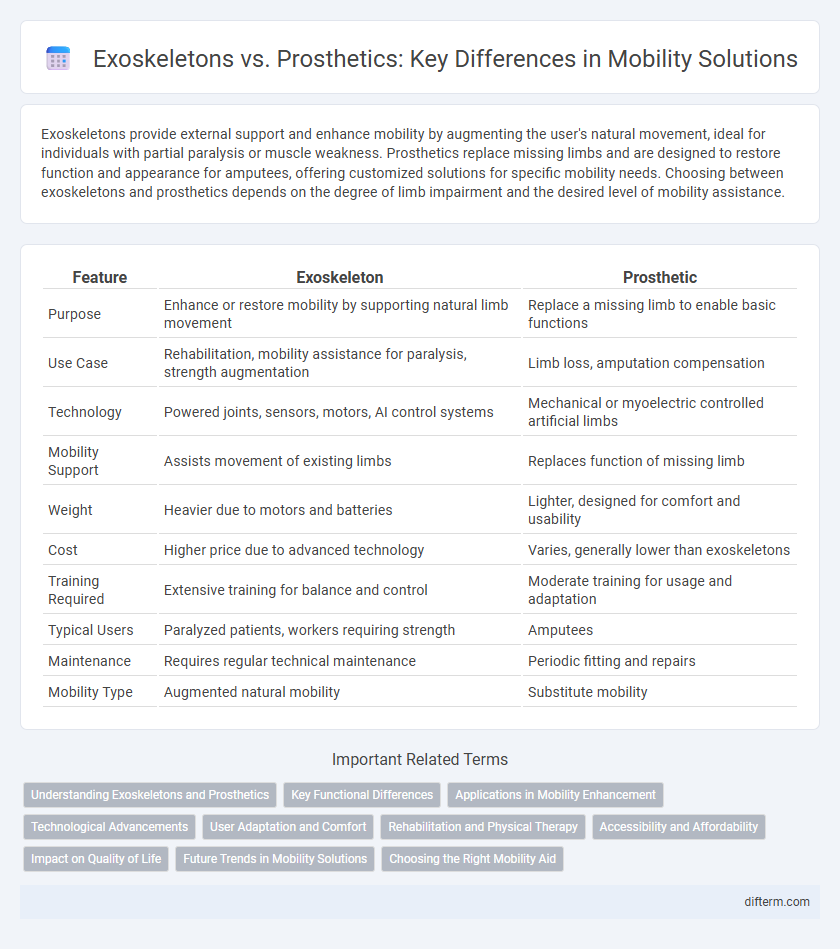Exoskeletons provide external support and enhance mobility by augmenting the user's natural movement, ideal for individuals with partial paralysis or muscle weakness. Prosthetics replace missing limbs and are designed to restore function and appearance for amputees, offering customized solutions for specific mobility needs. Choosing between exoskeletons and prosthetics depends on the degree of limb impairment and the desired level of mobility assistance.
Table of Comparison
| Feature | Exoskeleton | Prosthetic |
|---|---|---|
| Purpose | Enhance or restore mobility by supporting natural limb movement | Replace a missing limb to enable basic functions |
| Use Case | Rehabilitation, mobility assistance for paralysis, strength augmentation | Limb loss, amputation compensation |
| Technology | Powered joints, sensors, motors, AI control systems | Mechanical or myoelectric controlled artificial limbs |
| Mobility Support | Assists movement of existing limbs | Replaces function of missing limb |
| Weight | Heavier due to motors and batteries | Lighter, designed for comfort and usability |
| Cost | Higher price due to advanced technology | Varies, generally lower than exoskeletons |
| Training Required | Extensive training for balance and control | Moderate training for usage and adaptation |
| Typical Users | Paralyzed patients, workers requiring strength | Amputees |
| Maintenance | Requires regular technical maintenance | Periodic fitting and repairs |
| Mobility Type | Augmented natural mobility | Substitute mobility |
Understanding Exoskeletons and Prosthetics
Exoskeletons are wearable robotic devices designed to enhance mobility and strength by supporting or augmenting natural limb movement, often used for rehabilitation or assistance in physical tasks. Prosthetics replace missing limbs with artificial devices tailored to restore partial or full function, emphasizing restoration rather than augmentation. Understanding the biomechanics, control mechanisms, and user-specific needs is essential to optimize the integration and effectiveness of both exoskeletons and prosthetics in mobility solutions.
Key Functional Differences
Exoskeletons provide external support to enhance or restore mobility by enabling limb movement through powered joints and sensors, whereas prosthetics replace missing limbs and focus on replicating the form and function of natural anatomy. Exoskeletons are primarily used to assist individuals with impaired mobility, offering strength augmentation and rehabilitation benefits, while prosthetics are custom-fitted devices designed for daily use to improve independence after limb loss. The key functional difference lies in exoskeletons supporting existing limbs for movement, contrasted with prosthetics substituting absent limbs entirely.
Applications in Mobility Enhancement
Exoskeletons enhance mobility by providing external robotic support to individuals with impaired limb function, aiding in walking, standing, and balance restoration. Prosthetics replace missing limbs, restoring basic mobility and functionality for activities like walking and grasping, tailored to the amputee's needs. Both technologies significantly improve quality of life but serve distinct roles: exoskeletons assist existing limbs, while prosthetics substitute lost ones.
Technological Advancements
Exoskeletons and prosthetics have witnessed significant technological advancements aimed at enhancing mobility and user experience. Modern exoskeletons integrate AI-driven sensors and lightweight materials to improve movement precision and reduce fatigue, while prosthetics benefit from neural interface technologies allowing more intuitive control and sensory feedback. These innovations collectively push the boundaries of human-machine interaction, offering greater independence for individuals with mobility impairments.
User Adaptation and Comfort
Exoskeletons offer enhanced user adaptation by providing adjustable support that aligns with the wearer's natural movement patterns, promoting comfort through customizable fit and weight distribution. Prosthetics, designed to replace missing limbs, prioritize a snug socket interface and biomechanical synchronization to minimize discomfort and improve gait efficiency. Both technologies leverage advanced materials and ergonomic designs to optimize long-term wearability and functional integration.
Rehabilitation and Physical Therapy
Exoskeletons enhance rehabilitation by providing powered, repetitive motion that promotes neuroplasticity and muscle strengthening for patients recovering from spinal cord injuries or strokes. Prosthetics primarily restore limb function and mobility but require intensive physical therapy to adapt and maximize usage. Combining exoskeleton technology with prosthetic devices can accelerate physical therapy outcomes by improving gait training and reducing muscle atrophy.
Accessibility and Affordability
Exoskeletons generally offer greater accessibility for users with limited mobility, as they do not require surgical intervention and can be adjusted for various body types. Prosthetics, while often more affordable, may involve higher long-term maintenance costs and are typically limited to limb replacement rather than full mobility assistance. Advances in technology and manufacturing are gradually reducing costs for both, improving access for a wider population.
Impact on Quality of Life
Exoskeletons enhance mobility and independence by supporting natural gait patterns and reducing physical strain, significantly improving users' quality of life through increased endurance and reduced fatigue. Prosthetics restore limb functionality by enabling basic movement and dexterity, offering personalized solutions that facilitate daily activities and boost psychological well-being. Both technologies contribute uniquely to rehabilitation outcomes, with exoskeletons favoring active mobility support and prosthetics focusing on limb replacement and fine motor skills restoration.
Future Trends in Mobility Solutions
Emerging mobility solutions are increasingly integrating exoskeleton technology to enhance user strength and endurance, offering dynamic support beyond traditional prosthetics. Innovations in lightweight materials and AI-driven adaptive control systems enable exoskeletons to provide personalized assistance, improving gait and reducing fatigue for both disabled and elderly populations. Future mobility trends emphasize hybrid models combining prosthetics with exoskeleton enhancements, promising transformative improvements in user autonomy and rehabilitation outcomes.
Choosing the Right Mobility Aid
Choosing the right mobility aid depends on individual needs, with exoskeletons offering enhanced support for those with lower limb paralysis by providing powered walking assistance, while prosthetics focus on replacing lost limbs to restore basic mobility and functionality. Exoskeletons improve gait and posture by enabling upright walking, beneficial for rehabilitation and long-term mobility, whereas prosthetics prioritize limb replacement with customized designs for varied activity levels. Evaluating factors such as the level of mobility required, comfort, weight, and cost helps determine the most effective choice between exoskeletons and prosthetic devices.
exoskeleton vs prosthetic Infographic

 difterm.com
difterm.com